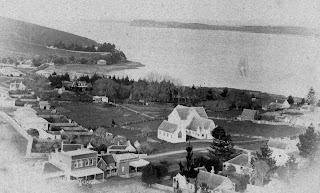 |
| Looking across Torpedo Bay to the Masonic Hotel, 1879. Image SGGSC APL 4-2979 |
When we visit Devonport in Auckland today it is hard to visualise it as a vital centre of industry, but it was. The 1850’s through to the late 1880’s were a peak time for ship building. Devonport was a major hub for this boom in maritime construction and the associated trade services. This post looks at three of the earliest ship yards in Devonport with a focus on community and connections.
Torpedo Bay was the area where the bulk of early boat building was carried out. Alex Alison was one of the first to set up a boat building yard in Devonport. He purchased property on the foreshore. King Edward Parade follows his seaward boundary, which extended to just east of where the Masonic Tavern was to be built.
 |
| Torpedo Bay Devonport about 1870 Image BFA |
The Alison home was one of the earliest wooden dwellings in Devonport. At that time the area was characterised by Maori settlement with only a few scattered settler farms. About 1854 he moved his boat building operation from Official Bay across to Devonport.
At Torpedo Bay he continued to specialise in smaller craft which he built for sale, rather than the more conventional practice of building to order.
 |
| DSC 27 Jan 1854 |
Alison's ‘Foam’ was a clinker built copper fastened boat launched 2 April 1855 whose construction included some of Duder Bros cement between skins. Could that be a first in New Zealand boat building? She made a good showing in the Auckland Anniversary regattas.
 |
| DSC 30 Jan 1857 |
His sons Alex and Ewen, in particular, left an indelible mark on Devonport and Takapuna. Their involvement in local politics, racing, ferry services is legendary on the North Shore. The pioneering contribution of the Alisons is remembered in the clock tower at the base of Victoria Rd. Alex’s grandson Ewen later married Freda Bartley, daughter of Clement.
George Beddoes set up his boat building yard at the North Head end of Torpedo Bay in the late 1850’s, until his remove to Fiji around 1872, in the midst of a Supreme Court Appeal concerning the Devonport wharf.
Alex Alison’s son Ewen was apprenticed to him. For a short while he was in partnership with John Holmes, who came to New Zealand via Melbourne. Later he moved further along the Bay to build a slip near where the Rowing Club is based. Beddoes’ yard is credited with building the first composite iron and wood vessel constructed in Auckland. This was the ferry ‘Devonport’ launched in 1870.
John Holmes was soon joined by his brothers James and William when fundamental differences led to the partnership with Beddoes being dissolved.
Holmes Bros, as their business became known, built a slip at the bottom of Victoria Road near the landing reserve, where the wharf buildings are today. There the first North Shore built steam ferry – the ‘Waitemata’- was constructed. Their first ferry services company Waitemata Steam Ferry Company did not prosper and folded in 1867. The steamer was transferred to a new company- the North Shore Steam Ferry Company and renamed.
 |
| The remodelled 'Waitemata' renamed 'Enterprise II' constructed 1865 Image SGGSC APL |
 |
| Another Holmes Bros paddle steamer 'Enterprise 1' Image SGGSC APL c 1867 |
Like the Bartley’s, the Holmes family came from St Helier, Jersey. After leaving the Channel Islands, their family moved to Sunderland, England and Australia. In Auckland they were able to re-establish their close connection with the Bartley brothers, Robert and Edward, who had moved to New Zealand in 1854.
John Holmes daughter Polly (Mary Elisabeth) married Arthur Bartley, son of Edward.
 |
| The family home of William Holmes on the foreshore at Devponport. Image SGGSC APL c1880 |
There was close cooperation between these early settlers at Devonport, but they were also highly competitive. Not only Anniversary Day Regattas were fiercely contested. Competition to control North Shore ferry services was cut throat, particularly between the Holmes brothers and the Alisons. Disputes arose as to the best placement of passenger facilities and various other commercial concerns. Local body affairs were sometimes coloured by the factions formed around business these concerns. The 1870 dispute over Alex Alison’s shoreline wall is one example. It took nearly twenty years and the Supreme Court to resolve this issue.
Conversely, it was that same single minded commitment and investment which led to the rapid development of the district. Improvement in ferry services was a key factor in opening up the North Shore for residential settlement. Edward Bartley was just one who delayed his move across the harbour from Auckland until 1870. Anyone with business interests in Auckland required a reliable commuter service. Anyone producing goods and services on the Shore for Auckland markets was equally dependent on steady freight services.
The personalities, prosperity and development associated with the boat building industry contributed immeasurably to the development of Devonport in social as well as economic terms.










